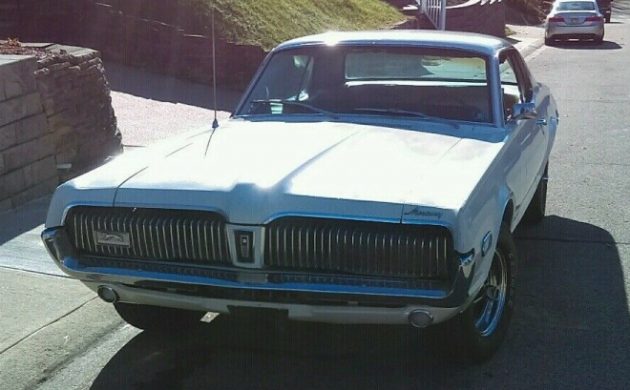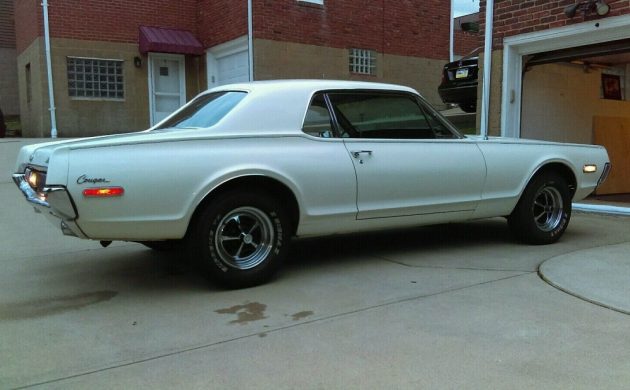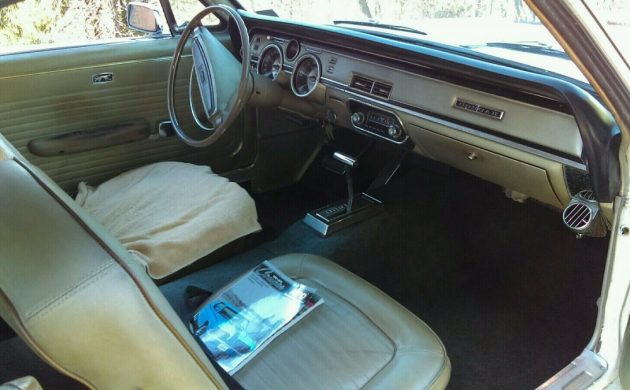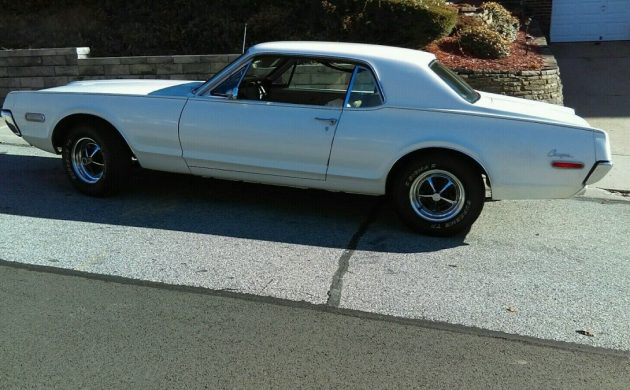During the 1960s, the Ford Motor Company was riding the crest of a wave. The success of their Mustang best exemplified this. Mercury wished to follow suit with their own version of a pony car, but Ford management was initially skeptical and was hesitant to give the project the green light. However, they eventually relented, and the Mercury Cougar was the result. Based on the Mustang platform, it was yet another wise decision. The Cougar, in various forms, would eventually go on to become Mercury’s highest-selling model. This 1968 example is a bit of a gem. It is a rust-free survivor that is ready to be driven and enjoyed. If you would like a pony car with a touch of luxury, you will find this Cougar located in Pittsburgh, Pennsylvania, in and listed for sale here on eBay. Bidding currently sits at $11,000, but this figure is short of the reserve.
It appears that the owner found this Cougar squirreled away in a barn in 2015. When he washed away the years of accumulated dust, he discovered a classic that was in remarkably good condition. Its Polar White paint isn’t perfect, but it is definitely acceptable for a survivor-grade car. It holds a good shine, with no significant flaws or defects. The panels are extremely straight, and the gaps appear tight and consistent. However, the big news here is this car’s lack of rust. There is nothing visible in the supplied photos, especially in prone areas like the lower rear quarter panels, rockers, and lower fenders. The owner says that the underside is equally clean, meaning that this is a structurally sound car that requires no significant restoration work. The exterior trim is in good condition for a survivor, and the owner says that the sequential turn signals work as they should. The glass shows no evidence of problems, and the Magnum 500 wheels add a muscular touch to the exterior.
One of the core differences between the Cougar, and the Mustang upon which it was based, was engine choice. While Mustang buyers could still slot a six under the hood of their new toy, the Cougar was strictly V8 territory. Our feature car rolled off the line equipped with a C-Code 289ci V8 that produced 200hp. The original owner also selected a three-speed automatic transmission, and this combination should see the Cougar race through the ¼ mile in 16.7 seconds. The seller doesn’t indicate whether this Cougar is a numbers-matching survivor, but it appears that it is in mechanically good health. My only concern centers around the coolant staining on the radiator, but since this looks pretty old, there may be nothing to worry about. The owner has worked through returning the car to a roadworthy state, rebuilding the transmission and the carburetor. He says the Cougar runs and drives perfectly and is ready to be driven away by its lucky new owner.
The Cougar’s Ivy Gold interior trim continues the “tidy survivor” theme. Its general presentation is pretty good, with no significant issues or problems visible. My only qualm is the cover over the driver’s seat. The owner mentions no problems in this area, but I would like to look at the vinyl beneath. If it’s tattered or torn, it is not the end of the earth. Replacement seat upholstery is available, although it does tend to be slightly more expensive than for a Mustang. There is also some wear and staining on the driver’s door trim where somebody’s arm has been rubbing for years. Otherwise, the remaining upholstered surfaces, carpet, dash, and pad, are excellent. The Cougar brought an additional level of luxury over its Mustang cousin, with slightly better trim and more sound deadening material. This car also features factory air conditioning and a pushbutton AM radio. There have been no aftermarket additions, which is a bit of a rarity in a Cougar of this vintage.
While Ford was initially hesitant to give the Cougar the green light, its approval proved a wise decision. Sales didn’t reach the frenetic level of the Mustang, generally landing at volumes of around ⅓ of the iconic pony car. In 1968, the company found 113,720 buyers for their Cougar range, which was pretty respectable. Today, these cars offer potential buyers the performance of a classic Mustang in a package with extra touches of luxury. Our feature car is a tidy survivor, and I won’t be surprised if the bidding passes $20,000 before the hammer falls. When it does, it appears that someone will be driving away in a classic that should offer many years of motoring pleasure. I can’t see a bad side to that, can you?






idk if that’s coolant staining, maybe acid fumes from the battery reacting with the brass tank……
I believe they did offer a 289 option in 1968 as they dropped it for the 302 as a base. So the year could be 1967. I’m not an expert in Mercury’s as I am an Oldsmobile Guy.
It’s a 68, the side marker lights give it away. I owned a 68 pretty much identical to this one optionwise but it was light green with a black vinyl top.
Currently 15,100. And it’s not even an XR7.
1967 had 289s
1968 had 302s as base engine only
I believe that the 289 was offered beginning in mid-year. The 302 was standard for the XR7. So, if I remember correctly, you could get either the 289 or the 302. I think the Mustang in 68 had 289’s and 302’s. I could be wrong.
During the 1968 model year there was a strike at the plant producing the new 302 engines. This limited the available number of 302 engines. What Mercury did was to make the C code 289 2V engine the base engine for a standard Cougar, which is what this car is. The F code 302 2V engine became the base engine for the Cougar XR-7. So you will find quite a few standard 1968 Cougars with a C code 289 2V factory installed.
You could also get a 289 in a Mustang and Falcon that year.
Early 68’s had 289s as well
Give Ford credit. They didn’t make the Cougar just a rebadged Mustang, they made it a classier version of a pony car. I always liked these.
I parted out a 68 cougar I found on the reservation. I thought I could use some of the parts on a 68 MustNg race car I was building. Nothing and I mean nothing would from the cougar would fit the Mustang except the windshields. I was also impressed at how much better built the cougar was
I guess since you were building a race car there were a lot of parts that you would not have bothered with. But there are a lot more parts than just the windshields that will interchange. Vent windows, door glass, window regulators, door latches, window cranks, heater box, console parts, lots of other small interior parts, complete rear axle, brakes, most front suspension parts, engine, transmission, radiator are all parts that quickly come to mind. In fact you can also bolt a Mustang door onto a Cougar. It does not look right but it will bolt right on and latch if properly aligned.
Cathouse, you`re pretty smart!
I am looking for a Cougar but am pretty specific on what it has to be and this is not it.
Pt Charlotte FL by way of Pittsburgh? It’s a flipper and a nice example.
Too bad they didn’t make these cars with a fastback roofline.
Cathouse. You are correct on much of what you say. I don’t believe the quarter windows work. Very little on the center console interchanges e crept maybe the “garage door”. I had a Mustang parts business for several years and found a lot of cougar stuff that wouldn’t work. I was also a front end mechanic for ten years and recall that suspension parts for the cougar carried different part numbers than a Mustang